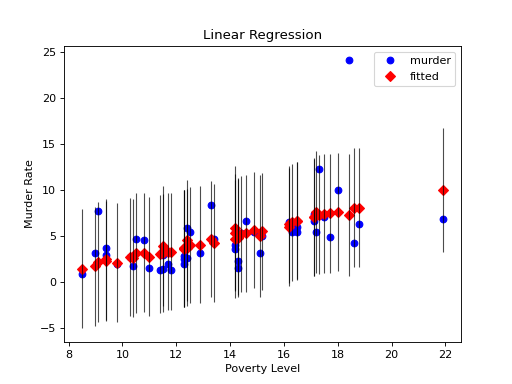statsmodels.graphics.regressionplots.plot_fit¶
-
statsmodels.graphics.regressionplots.plot_fit(results, exog_idx, y_true=
None, ax=None, vlines=True, **kwargs)[source]¶ Plot fit against one regressor.
This creates one graph with the scatterplot of observed values compared to fitted values.
- Parameters:¶
- results : Results¶
A result instance with resid, model.endog and model.exog as attributes.
- exog_idx : {int, str}¶
Name or index of regressor in exog matrix.
- y_true : array_like. optional¶
If this is not None, then the array is added to the plot.
- ax : AxesSubplot, optional¶
If given, this subplot is used to plot in instead of a new figure being created.
- vlines : bool, optional¶
If this not True, then the uncertainty (pointwise prediction intervals) of the fit is not plotted.
- **kwargs¶
The keyword arguments are passed to the plot command for the fitted values points.
- Returns:¶
If ax is None, the created figure. Otherwise the figure to which ax is connected.
- Return type:¶
Figure
Examples
Load the Statewide Crime data set and perform linear regression with poverty and hs_grad as variables and murder as the response
>>> import statsmodels.api as sm >>> import matplotlib.pyplot as plt>>> data = sm.datasets.statecrime.load_pandas().data >>> murder = data['murder'] >>> X = data[['poverty', 'hs_grad']]>>> X["constant"] = 1 >>> y = murder >>> model = sm.OLS(y, X) >>> results = model.fit()Create a plot just for the variable ‘Poverty.’ Note that vertical bars representing uncertainty are plotted since vlines is true
>>> fig, ax = plt.subplots() >>> fig = sm.graphics.plot_fit(results, 0, ax=ax) >>> ax.set_ylabel("Murder Rate") >>> ax.set_xlabel("Poverty Level") >>> ax.set_title("Linear Regression")>>> plt.show()(
Source code,png,hires.png,pdf)